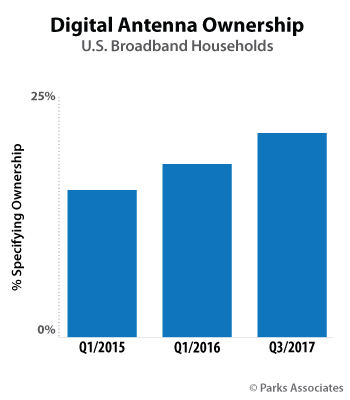 New consumer research from Parks Associates shows the percentage of U.S. broadband households that use digital antennas for live TV viewing in their home steadily increased to reach 20% near the end of 2017, up from 16% in early 2015.
New consumer research from Parks Associates shows the percentage of U.S. broadband households that use digital antennas for live TV viewing in their home steadily increased to reach 20% near the end of 2017, up from 16% in early 2015.
The new report, 360 View: Access and Entertainment Services in U.S. Broadband Households shows that a steady decline in pay-TV subscriptions and an increase in OTT video subscriptions coincides with the increase in digital antennas.
The Park Associate research also finds:
- Average fees for standalone broadband have increased nearly 25% since 2010
- Sixty-three percent of subscribers who cannot currently restart programs from the beginning find that feature to be appealing
- Nearly one in five (17%) of consumers who cancel their pay-TV service would have stayed with their provider if there were no monthly fees for their set-top boxes
- One-fifth of Wi-Fi households experience problems with coverage in their homes
“Increasingly, consumers are cobbling together their own bundles of content sources. Digital antennas are experiencing a resurgence as consumers consider over-the-air TV and OTT video services as alternatives to pay TV,” said Brett Sappington, Parks Associates’ senior director of research, in a prepared statement. “The percentage of ‘Never’ households (households that have never subscribed to pay-TV services) has held steady, and the percentage of households actually cutting the cord has increased between 2015 and 2017. Antennas are an affordable source for local channels to these households.”

The report also says that high cost and low price/value perception dominate reasons for service cancellation and bundle shaving. More than half of the households that have switched, shaved or cut the cord cite the service is not worth the cost.
“Pay-TV providers need to address this value perception gap and re-establish their role as the consumers’ source for interesting content,” Sappington said, in a prepared statement. “Opportunities are available. Only 46% of pay-TV subscribers are aware that they can access video-on-demand content from their operator, including free programming. Many indicate that they want to purchase online video services through their pay-TV provider and to access the service through their channel guide.”
Image courtesy of flickr user D.Reichardt.


